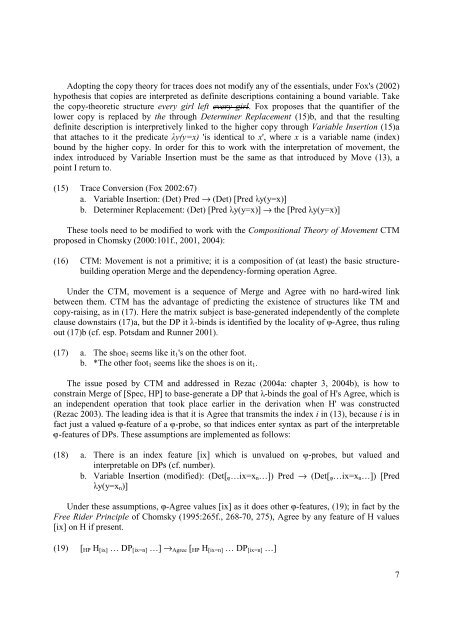1 On tough-movement* Milan Rezac, University ... - Multimania.co.uk
1 On tough-movement* Milan Rezac, University ... - Multimania.co.uk
1 On tough-movement* Milan Rezac, University ... - Multimania.co.uk
Create successful ePaper yourself
Turn your PDF publications into a flip-book with our unique Google optimized e-Paper software.
Adopting the <strong>co</strong>py theory for traces does not modify any of the essentials, under Fox's (2002)<br />
hypothesis that <strong>co</strong>pies are interpreted as definite descriptions <strong>co</strong>ntaining a bound variable. Take<br />
the <strong>co</strong>py-theoretic structure every girl left every girl. Fox proposes that the quantifier of the<br />
lower <strong>co</strong>py is replaced by the through Determiner Replacement (15)b, and that the resulting<br />
definite description is interpretively linked to the higher <strong>co</strong>py through Variable Insertion (15)a<br />
that attaches to it the predicate λy(y=x) 'is identical to x', where x is a variable name (index)<br />
bound by the higher <strong>co</strong>py. In order for this to work with the interpretation of movement, the<br />
index introduced by Variable Insertion must be the same as that introduced by Move (13), a<br />
point I return to.<br />
(15) Trace Conversion (Fox 2002:67)<br />
a. Variable Insertion: (Det) Pred → (Det) [Pred λy(y=x)]<br />
b. Determiner Replacement: (Det) [Pred λy(y=x)] → the [Pred λy(y=x)]<br />
These tools need to be modified to work with the Compositional Theory of Movement CTM<br />
proposed in Chomsky (2000:101f., 2001, 2004):<br />
(16) CTM: Movement is not a primitive; it is a <strong>co</strong>mposition of (at least) the basic structurebuilding<br />
operation Merge and the dependency-forming operation Agree.<br />
Under the CTM, movement is a sequence of Merge and Agree with no hard-wired link<br />
between them. CTM has the advantage of predicting the existence of structures like TM and<br />
<strong>co</strong>py-raising, as in (17). Here the matrix subject is base-generated independently of the <strong>co</strong>mplete<br />
clause downstairs (17)a, but the DP it λ-binds is identified by the locality of φ-Agree, thus ruling<br />
out (17)b (cf. esp. Potsdam and Runner 2001).<br />
(17) a. The shoe 1 seems like it 1 's on the other foot.<br />
b. *The other foot 1 seems like the shoes is on it 1 .<br />
The issue posed by CTM and addressed in <strong>Rezac</strong> (2004a: chapter 3, 2004b), is how to<br />
<strong>co</strong>nstrain Merge of [Spec, HP] to base-generate a DP that λ-binds the goal of H's Agree, which is<br />
an independent operation that took place earlier in the derivation when H' was <strong>co</strong>nstructed<br />
(<strong>Rezac</strong> 2003). The leading idea is that it is Agree that transmits the index i in (13), because i is in<br />
fact just a valued φ-feature of a φ-probe, so that indices enter syntax as part of the interpretable<br />
φ-features of DPs. These assumptions are implemented as follows:<br />
(18) a. There is an index feature [ix] which is unvalued on φ-probes, but valued and<br />
interpretable on DPs (cf. number).<br />
b. Variable Insertion (modified): (Det[ φ …ix=x n …]) Pred → (Det[ φ …ix=x n …]) [Pred<br />
λy(y=x n )]<br />
Under these assumptions, φ-Agree values [ix] as it does other φ-features, (19); in fact by the<br />
Free Rider Principle of Chomsky (1995:265f., 268-70, 275), Agree by any feature of H values<br />
[ix] on H if present.<br />
(19) [ HP H [ix] … DP [ix=n] …] → Agree [ HP H [ix=n] … DP [ix=n] …]<br />
7
















